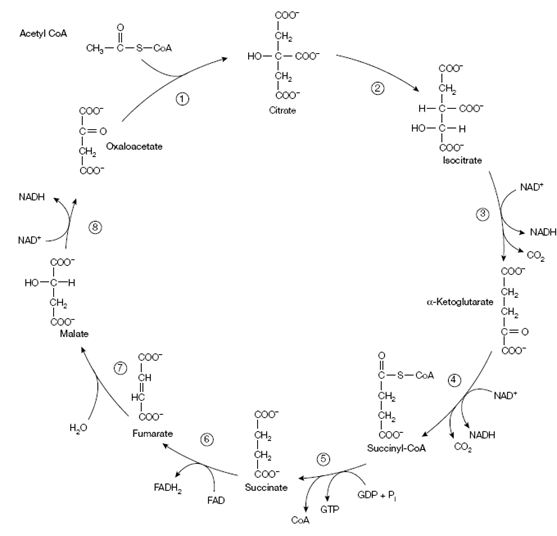Cycle:
The cycle forms the middle part of a three-step process which oxidizes organic fuel molecules into CO2 with the concomitant production of ATP.
Steps 1 - Oxidation of fuel molecules to acetyl CoA
A main source of energy is glucose that is converted through glycolysis into pyruvate. Pyruvate dehydrogenase (a complex of three enzymes and five coenzymes) then oxidizes the pyruvate (using NAD+ that is reduced to NADH) to create CO2and acetyl CoA. Because the reaction includes both an oxidation and a loss of CO2, the procedure is known as oxidative decarboxylation.
Step 2 - The citric acid cycle
The cycle holds out the oxidation of acetyl groups from acetyl CoA to CO2 with the production of four pairs of electrons which stored initially in the reduced electron carriers FADH2 and NADH.
The cycle has eight stages that are:
1. Citrate (6C) is created from the irreversible condensation of acetyl CoA (2C) and oxaloacetate (4C) - catalyzed through citrate synthase.
2. Citrate is transformed to isocitrate (6C) through an isomerization catalyzed by aconitase. This is really a two-step reaction during which cis-aconitate is creating as an intermediate. It is the cis-aconitate that provides the enzyme its name.
3. Isocitrate is oxidized to α-ketoglutarate (5C) and CO2 through isocitrate dehydrogenase. This mitochondrial enzyme needs NAD+ that is reduced to NADH.
4. α-Ketoglutarate is oxidized to succinyl CoA (4C) and CO2 through the α-ketoglutarate dehydrogenase complex. Such as pyruvate dehydrogenase, that is a difficult of three enzymes and uses NAD+ as a cofactor.
5. Succinyl CoA is converted to succinate (4C) by succinyl CoA synthetase. The reaction uses the energy released through cleavage of the succinyl-CoA bond to synthesize either GTP (mainly in animals) or ATP (exclusively in plants) from Pi and, correspondingly GDP or ADP.
6. Succinate is oxidized to fumarate (4C) through succinate dehydrogenase. FAD is strongly bound to the enzyme and is decrease to produce FADH2.
7. Fumarate is converted to malate (4C) through fumarase; this is a hydration reaction needed the addition of a water molecule.

Figure: The citric acid cycle (reactions 1-8 are described in the text).
8. Malate is oxidized to oxaloacetate (4C) through malate dehydrogenase. NAD+ is again needs through the enzyme as a co-factor to accept the free pair of electrons and produce NADH.
Step 3 - Oxidation of NADH and FADH2
Produced through the citric acid cycle The NADH and FADH2 produced through the citric acid cycle are re-oxidized and the energy released is used to synthesize ATP through oxidative phosphorylation.